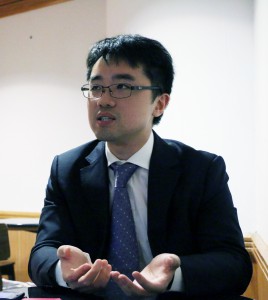Daniel Cheung Ka-ki and Lee Ho-yin, teachers at SKH St. Mary’s Church Mok Hing Yiu College, agree. The school is an EMADS partner school and for the past three years, they have been promoting e-textbook learning and conducting e-textbook training in teacher professional development courses organised by the EDB.
Lee says it is difficult to encourage teachers to teach with e-textbooks as some of them do not have an adequate level of IT knowledge. “Some [teachers] don’t even know the home button leads you back to the home page [on the iPad],” he says. Cheung also recalls that some teachers could not handle technical issues arising in the trial lessons, which made them sceptical about e-textbooks.
However, he thinks teachers’ deficiency in IT skills is not the major problem because this can be overcome with training. Instead Cheung says some teachers and even school principals are close-minded about e-textbooks. “Teachers will ask, ‘Why would this iPad be better than a traditional textbook? We were all trained through teachings from textbooks and our teaching has been fine. Why should I have to change?’”
To overcome such prejudices and better illustrate the advantages of e-textbooks, Lee and Cheung organise classes and provide individual advice for schools that are also willing to implement e-textbook learning.

Cheung agrees that not every class or subject is suitable for e-textbook learning, especially in senior secondary classes as students have to prepare for public exams. “It might be good for interactive activities such as experiments if there is a video in an e-textbook [for demonstration],” he says. “However for some subjects that require intense exam practice, perhaps it is better not to use e-textbooks.”
It seems resistance to e-textbooks from some teachers and parents is holding back their development in Hong Kong, but Cheung thinks it is only a matter of time before they catch on. He says it took quite some years for teachers to shift from using blackboards to PowerPoint presentations. Therefore he predicts another eight to 10 years is needed for a shift from printed books to e-textbooks among teachers.
Jeff Sze Chun-fai, the political assistant to the Secretary for Education, says firmly that “e-textbooks will not replace printed textbooks,” when explaining that the ultimate aim of the government is to empower students to self-learn in this technological era, rather than make students use them in all subjects.
Responding to e-textbook publishers complaints about the tough clauses in EMADS, he says the EDB cannot amend the terms easily as the Legislative Council Finance Committee would question the change. He says the purpose of EMADS is to gain experience in e-learning. “Schools have to feel prepared first,” Sze explains. “Trial lessons are a partnership [between publishers and schools]. The role of government is as a middleman…and to ask for funding from the Legislative Council to support publishers.”
Apart from being a middleman, Sze adds the government’s involvement is a strong guarantee to ease schools’ concerns about e-textbook learning, such as the quality of different e-textbooks. He says the government has already implemented other policies to advance e-learning, such as providing 900 public sector schools with funding to enhance their Wi-Fi infrastructure in three years and giving around HK$700,000 to every school to purchase e-learning software and materials.
There have been a lot of obstacles, but Sze says the EDB is already thinking about the next step in pushing e-learning. “We could not force teachers to use e-textbooks. We just need to give them time to get ready,” says Sze. “We will continue to implement e-textbook learning because it is the trend.”
Edited by Henry Lee






































